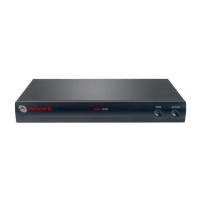
Do you have a question about the Avocent HMX and is the answer not in the manual?
| Type | KVM extender |
|---|---|
| Resolution Support | Up to 1920x1200 |
| USB Support | Yes |
| Distance | Up to 100 meters |
| Video Interface | DVI |
| Audio | Yes |
| Power Supply | External |
| Operating Temperature | 0°C to 40°C |
| Storage Temperature | -20°C to 60°C |
Overview of the HMX extender system, its components, and functionality.
Details about the system's security, upgradability, and network addressing capabilities.
Details on how transmitters connect, their power sources, and media stream processing.
Explains how user stations connect peripherals to the target workstation via the network.
Describes the OSD for viewing system configuration.
Details serial menu for admin tasks like network config and firmware upgrades.
Explains functionality of mass storage devices connected via HMX user station.
Explains the different operating modes: Extender, Desktop, Matrix, and Share.
Provides guidance to avoid potential video and keyboard problems.
List of items and steps required for installing the HMX 1050 User Station.
Describes how the HMX 1050 user station mounts to a flat panel monitor.
Describes point-to-point and networked installation configurations.
Details the direct, out-of-the-box installation method for HMX systems.
Instructions for connecting the external power supply to the HMX 1050 user station.
Steps for setting up multiple HMX units on a network via Ethernet.
List of items and steps for installing HMX 1070 and 2050 User Stations.
Details the direct installation method for HMX 1070/2050.
Instructions for connecting the external power supply to HMX 1070/2050 user stations.
Steps for setting up HMX 1070/2050 units on a network.
General information on operating the HMX system and configuring settings.
Describes the status LEDs on the front and rear panels of the HMX user station.
How to initiate a connection and interact with the remote workstation.
Details about using the On-Screen Display for system configuration and information.
How to set IP address, Netmask, and Default Gateway via the OSD.
Configures how long the On-Screen Display remains visible.
Configures automatic disconnection after inactivity.
Steps to connect to a remote computer when the system is in Matrix Mode.
How administrators can enable and use Auto-Login Mode for user stations.
Steps to view system information for the HMX user station in Extender Mode.
Overview of the serial menu's capabilities for configuration and maintenance.
Details on changing network settings for transmitters and user stations.
Procedure for upgrading firmware via XMODEM or HTTP.
Steps to reset both user station and transmitter to factory default settings.
Procedure for resetting the HMX user station or transmitter.
How to set video input types (DVI/VGA) for transmitters and user stations.
Configuring preferred monitor resolutions for transmitters.
Adjusting the automatic connection retry interval and count.
Changing the key sequence used to activate the On-Screen Display.
Configuring the time before the OSD automatically dismisses.
Modifying audio performance levels or disabling audio support.
Setting up the display power saving mode feature.
Configuring automatic logout timer via the serial menu.
Allows multiple users to share audio/video and arbitrate control of a target computer.
Explains initial control and relinquishing of keyboard/mouse in Share Mode.
How Share Mode can be configured via HMX Manager or serial menu.
Requirements for monitors in a Share Mode group.
Details on operating Share Mode with HMX stations in Extender Mode.
How to make a Share Mode connection when user stations are in Desktop Mode.
Using SAMI for limited control of HMX transmitters/stations via ASCII protocol.
Steps to access and navigate the SAMI Menu for configuration.
Details on Ethernet standard and IP port usage for HMX 1070/2050.
Information on the RJ-45 connectors for extension ports.
Specifications for USB, DVI-I/DVI-D, audio, and power jacks.
Physical dimensions of the HMX 1070/2050 User Stations.
Weight of the HMX 1070/2050 User Stations.
Details on heat dissipation, power consumption, and operating conditions.
Lists supported peripherals like keyboards, mice, and speakers.
Lists types of mass storage devices supported by the HMX system.
Supported video resolutions and refresh rates for HMX systems.
Lists safety and EMC certifications obtained.
Details Ethernet standard and IP port usage for transmitters.
Information on the RJ-45 connectors for extension ports.
Specifications for USB and video ports on transmitters.
Physical dimensions of the transmitters.
Weight of the transmitters.
Details on heat dissipation, power consumption, and operating conditions.
Supported video resolutions and refresh rates for transmitters.
Settings for normal or wide screen resolutions.
Lists safety and EMC certifications.
Factory default settings for HMX 1050, 1070, and 2050 User Stations.
Factory default settings for HMIQDI, HMIQSHDI, and HMIQDHDD Transmitters.
Steps to follow when encountering installation or operating issues with Avocent products.
Troubleshooting steps for a user station with no power light.
Troubleshooting steps for no video output on the user station monitor.
Troubleshooting steps for non-responsive peripherals.
Troubleshooting steps for no audio output from speakers.
Troubleshooting steps for degraded video quality on the monitor.
Troubleshooting steps for USB mass media devices not responding.
Troubleshooting steps for slow file transfer rates with USB mass media devices.
Troubleshooting steps when the connection to the remote workstation is lost.
Troubleshooting steps for transmitter disconnection from DHCP server in Extender Mode.
Troubleshooting steps for transmitter disconnection from DHCP server in Matrix Mode.
Lists and describes error messages that occur during HMX 1050 user station login.